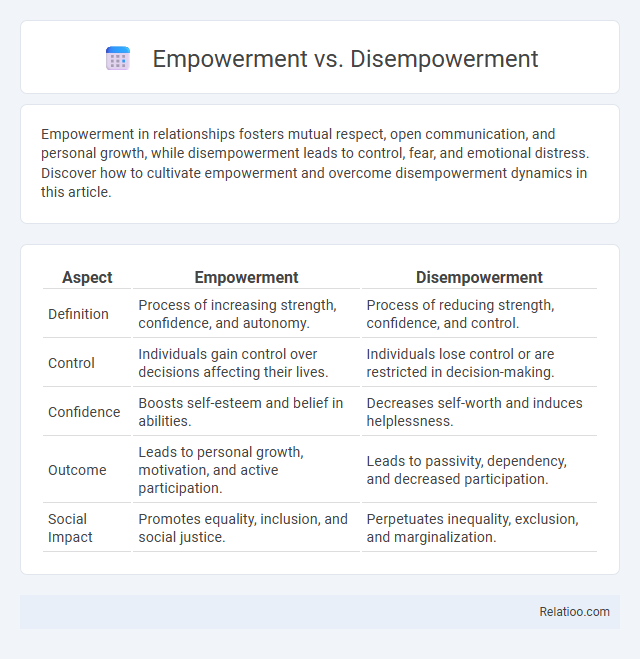Empowerment in relationships fosters mutual respect, open communication, and personal growth, while disempowerment leads to control, fear, and emotional distress. Discover how to cultivate empowerment and overcome disempowerment dynamics in this article.
Table of Comparison
| Aspect | Empowerment | Disempowerment |
|---|---|---|
| Definition | Process of increasing strength, confidence, and autonomy. | Process of reducing strength, confidence, and control. |
| Control | Individuals gain control over decisions affecting their lives. | Individuals lose control or are restricted in decision-making. |
| Confidence | Boosts self-esteem and belief in abilities. | Decreases self-worth and induces helplessness. |
| Outcome | Leads to personal growth, motivation, and active participation. | Leads to passivity, dependency, and decreased participation. |
| Social Impact | Promotes equality, inclusion, and social justice. | Perpetuates inequality, exclusion, and marginalization. |
Understanding Empowerment: Key Concepts and Definitions
Empowerment involves enhancing individuals' or groups' ability to make decisions, access resources, and take control over their lives, fostering self-efficacy and autonomy. Disempowerment results from systemic barriers, exclusion, or oppression that restrict access to power, rights, and opportunities, leading to reduced agency. Diminishment refers to the process by which individuals' capacities or contributions are undervalued or minimized, weakening their confidence and sense of influence.
What Is Disempowerment? Root Causes and Effects
Disempowerment occurs when individuals or groups lose control over their own lives, often due to systemic inequalities, lack of access to resources, or social exclusion. Root causes include poverty, discrimination, and oppressive institutional structures that limit one's ability to make decisions and assert rights. Your awareness of these effects--such as reduced self-esteem, marginalization, and diminished opportunities--can help foster strategies for empowerment and social change.
Empowerment vs Disempowerment: Core Differences
Empowerment involves enabling individuals with confidence, resources, and authority to make decisions and take control of their lives, fostering growth and self-efficacy. Disempowerment, in contrast, restricts autonomy and access to opportunities, often resulting in decreased motivation and diminished potential. The core difference lies in empowerment's promotion of agency and positive action versus disempowerment's limitation and control over an individual's capacities.
The Psychological Impact of Empowerment
Empowerment significantly enhances your psychological well-being by fostering a sense of control, self-efficacy, and motivation, which are crucial for personal growth and resilience. Disempowerment, in contrast, often leads to feelings of helplessness, decreased self-esteem, and increased stress, negatively impacting mental health. Diminishment reduces one's perceived value, further undermining confidence and hindering emotional and cognitive development.
Disempowerment: How It Undermines Confidence
Disempowerment erodes Your confidence by stripping away control, autonomy, and the ability to make decisions, leading to feelings of helplessness and self-doubt. It creates a negative feedback loop where reduced self-efficacy limits motivation and hampers personal growth. The pervasive impact of disempowerment diminishes resilience, making it difficult to overcome challenges and assert one's value in various contexts.
Empowerment in the Workplace: Benefits and Strategies
Empowerment in the workplace enhances employee motivation, productivity, and job satisfaction by giving individuals autonomy, decision-making authority, and access to resources. You can foster a culture of empowerment by implementing transparent communication, providing professional development opportunities, and encouraging collaborative problem-solving. Empowered employees drive innovation, increase organizational commitment, and reduce turnover rates, delivering measurable benefits to business performance.
Signs and Symptoms of Disempowerment
Disempowerment often manifests through signs such as reduced self-confidence, lack of motivation, and feelings of helplessness, which can significantly affect your ability to take initiative and make decisions. Symptoms include withdrawal from social interactions, increased dependence on others, and persistent self-doubt that undermines personal growth. Recognizing these indicators is crucial for addressing disempowerment and fostering a sense of empowerment.
Overcoming Disempowerment: Practical Steps
Overcoming disempowerment involves recognizing limiting beliefs and actively challenging negative narratives through self-awareness and assertive communication. Building supportive networks and seeking mentorship accelerates personal growth and reinforces confidence in decision-making. Implementing consistent goal setting and skill development empowers individuals to regain control and counter feelings of diminishment effectively.
Building a Culture of Empowerment
Building a culture of empowerment involves fostering environments where individuals feel valued, capable, and motivated to contribute meaningfully. Empowerment enhances autonomy and decision-making, resulting in increased engagement and innovation, whereas disempowerment and diminishment lead to reduced morale and stifled creativity. Organizations emphasizing trust, open communication, and supportive leadership effectively cultivate empowerment that drives sustainable success.
Empowerment for Sustainable Personal and Community Growth
Empowerment drives sustainable personal and community growth by fostering self-efficacy, confidence, and active participation in decision-making processes. Your ability to access resources, knowledge, and supportive networks creates a foundation for long-term development and resilience. Unlike disempowerment and diminishment, which limit potential and force dependency, empowerment cultivates autonomy and collective strength for enduring progress.

Infographic: Empowerment vs Disempowerment
 relatioo.com
relatioo.com